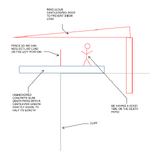infinitely_rigid
Structural
Hello,
This is a Canadian Building Code LSD (NBCC/OBC) related question, but I imagine there might be similar confusion in ASCE, IBC etc.
When you have a scenario when there are both active and counteracting dead loads, does your load combination become 1.25Dactive + 0.90Dcounter + 1.5L etc.
I don't think the building code explicitly states this, but I assumed it was implied.
An example of where this happens all the time is Metal Building System (PEMB) foundation design. Gravity loads drive horizontal thrust from the frames, i.e. active Dead Load. Footing Self-Weight, Soil Overburden would represent counteractive Dead Load. The active load in this scenario is theoretically both driving and counteracting, however one can't exist without the other so, I don't feel particularly obliged to split out the horizontal and vertical load into counteracting and active. The Foundation self-weight on the other hand is purely counteractive from a OT/Sliding standpoint, but for all the other limit states, would likely be considered active as it would increase bearing on the underside of footing etc.
Any opinions on this?
This is a Canadian Building Code LSD (NBCC/OBC) related question, but I imagine there might be similar confusion in ASCE, IBC etc.
When you have a scenario when there are both active and counteracting dead loads, does your load combination become 1.25Dactive + 0.90Dcounter + 1.5L etc.
I don't think the building code explicitly states this, but I assumed it was implied.
An example of where this happens all the time is Metal Building System (PEMB) foundation design. Gravity loads drive horizontal thrust from the frames, i.e. active Dead Load. Footing Self-Weight, Soil Overburden would represent counteractive Dead Load. The active load in this scenario is theoretically both driving and counteracting, however one can't exist without the other so, I don't feel particularly obliged to split out the horizontal and vertical load into counteracting and active. The Foundation self-weight on the other hand is purely counteractive from a OT/Sliding standpoint, but for all the other limit states, would likely be considered active as it would increase bearing on the underside of footing etc.
Any opinions on this?

